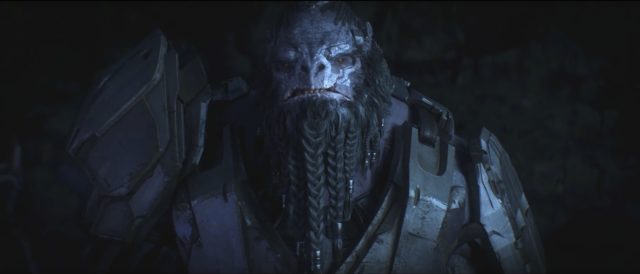
In 2004, the critically acclaimed and widely anticipated Halo 2 released on the Xbox, hailed for championing in a new age of multiplayer arena shooters and a competitive environment which still sees inspiration from this classic to this day. What did not receive this level of monumental esteem, however, was the story campaign. While by no means poorly executed, the finale seemed to fall flat for many with an infamous cliffhanger that still stings to this day. It’s a painful shame, since Halo 2 accomplished something that later Halo titles would completely miss, up until the recent release of Halo Wars 2. Halo 2 humanized the Covenant and their various races, understanding the oppression of the alien hierarchy and allowing the player to reconsider mindlessly popping Unggoy heads and blasting Sangheili to bits.
“Forty at a time they carelessly sent them in. Forty to break the front lines… Forty to die for beliefs not their own.”
In the Great Schism, a fracturing genocide presented in Halo 2 and Halo 3, the Jiralhanae are portrayed as dimwitted warriors, legions of snarling savages who fell lockstep behind the Prophets. Tartarus, a Jiralhanae figurehead featured prominently in Halo 2, partially toys with these ideas in his wavering faith, but soon becomes just another challenge to be overcome. This is where Atriox truly shines, a beacon of prevailing hope from an empire which treated the Jiralhanae as cannon fodder. Atriox has incredible potential as an antagonist, a perfect opposite to his fellow leader, Captain James Cutter. Cutter portrays traits of commitment, duty, order, and discipline. His harrowing defiance in a world that has all but forgotten about him makes him a sympathetic hero. Atriox, however, finds himself in an opposite position, forging his own path in an effort to avoid the mistakes of an empire which fecklessly neglected him and his people.
The arrival of Atriox as a major figure in the galactic post-war strife comes at a moment where his brand of antagonism is desperately needed. The lackluster narrative experience presented in Halo 5: Guardians was lambasted in almost every conceivable capacity, a monument to all of the game’s sins being its main adversary, Cortana. The return of one of Halo’s most iconic characters was by no means unexpected or shrouded in secrecy leading up to Halo 5’s release, but the context of her actions and her transformation from ally to foe was anticlimactic at best and insulting at worst. Cortana seemed to fall into harmful stereotypes and clichés as a lack of coherent understanding and build-up created a completely botched attempt at moral ambiguity. The goal of a villain is to intimidate, connect, and/or illustrate a point to the audience, and Cortana failed on all three fronts.
“As I suspected, nothing, but a man.”
The narrative of Halo Wars 2 focuses on the Spirit of Fire crew, and their repeated engagements with the Banished, all in an attempt to foil their efforts on the Ark and reconnect with post-war society. It’d be difficult to miss the symbolism surrounding the premise of the game; the idea of moving forward with characters we’ve grown attached to from the beginning of the war. The emotion all culminates for the player with the swell of the music, the beautiful interior of the Spirit of Fire, and the reminder that Halo hasn’t forgotten the military backbone that fueled its notoriety. Atriox’s brutal assault on Red Team is effective because it’s handled correctly, it showcases the brutality of a passionate and intelligent Jiralhanae and engages the audience by bringing our heroes to their lowest point. It serves as a reminder that this new world will not show mercy as long as Atriox has power, and in many ways, he becomes the demon he so desperately tried to escape in the Covenant regime.
Atriox is the prudent response to the backlash of Halo 5, triumphantly managing to become a prominent figure amongst fans despite his fairly recent introduction to the universe. His success is owed to not only his visually stimulating appearance, grizzly and formidable, but the brief characterization he is given. Despite only having seven total lines of dialogue in Halo Wars 2, Atriox has an engrossing screen presence and the struggle to combat this formidable warrior is tangible. He represents the best qualities in a villain, simple in nature, but captivating as you explore deeper into his psyche. He isn’t an all-powerful divine being, nor is he an emotionally barren cardboard cut-out. He represents an antithesis of everything he felt the Covenant stood for, stripping piety and theocracy from war. Atriox is not without flaw, and in his attempts to eradicate the viscous legacy of the Covenant, it would seem he’s simply created his own dictatorial regime. Much like the Arbiter, Thel ‘Vadam, did for the Sangheili, Atriox is a reminder to the human players that there is far more to the alien soldiers than we regard from the other side. After witnessing Atriox claw away the chains of his oppression, we’re forced to humanize the otherwise lifeless adversary, and emit unto them personality.
“I am not Truth. I am not Regret. I am their remedy.”
With a galaxy under threat of Orwellian absolute dominion by a rampant AI fragment, the slimy clutches of a Jiralhanae bent on burying his past present themselves as a fickle alternative. The shaky ground of Atriox’s authority proves itself subtly in Halo Wars 2. The re-emerging faith in the Great Journey of his second-in-command, Decimus, and the straining relations of the various races that make up the Banished, raise questions as to whether the promise of fortune and unity Atriox has offered was merely a pipe-dream. Only time will tell as the line between oppressor and liberator blurs.



 iTunes
iTunes Zune
Zune RSS
RSS Facebook
Facebook Twitter
Twitter Twitch
Twitch